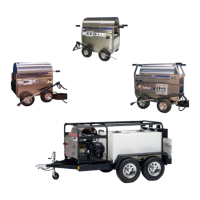DIESEL FIRED BURNER: The
diesel-fired burner is a forced
draft pressure-atomizing
burner. Diesel fuel is sprayed
out of an atomizing nozzle,
mixed with air, and ignited by a
high voltage spark. The flame
is directed towards the coils of pipe, which in turn,
heats the water flowing through it. Use clean #2
DIESEL FUEL for the burner or substitute #1
diesel, light fuel oil, or Kerosene if diesel is not
available.
AIR BAND adjustments may need to be made to
compensate for higher elevations, or if more than a
trace of smoke is observed in the burner exhaust.
The ELECTRODES may need to be cleaned and
adjusted periodically. These adjustments have to
be made precisely and should be performed only
by qualified personnel. Set between #1 & #2 on the
smoke gauge.
The FUEL PUMP is a self priming,
low volume pump which is propelled
by the burner motor. The fuel pump
pressure is typically set at 100 PSI
but can be turned as high as 140
PSI during the winter when the incoming water
temperature is lower. Before adjusting the fuel
pressure, connect a fuel pressure gauge and an
outlet water temperature gauge, turn the pump and
burner on, and turn the fuel pressure screw
clockwise until the desired water temperature is
obtained. Be sure not to exceed the recommended
specifications of the machine.
The FUEL FILTER will need to be replaced often if
the diesel fuel quality is poor. A fuel filter with a
water separator is recommended if the fuel quality
is consistently poor.
The FUEL SOLENOID is an electric fuel valve that
shuts off the fuel whenever the trigger on the spray
gun is released or if the set temperature on the
heat switch is exceeded.
The IGNITION TRANSFORMER provides a high
voltage spark that travels down the electrodes to
ignite the diesel fuel. Disconnect all power before
servicing.
The 12V burner operates from the battery on the
SS Series (and a limited number of SC Series).
The engine has a 15 to 20 amp charging system
that keeps the battery charged which runs the
burner. The burner motor and transformer stop
when the trigger gun is released and is controlled
through a high amperage contactor. To help keep
the battery fully charged, and for safely cooling
down the burner, turn off the burner during the last
minute of rinsing. When leaving the machine
unattended, shut off burner and engine switch.
Replace 12 VDC battery regularly (2 year maximum
interval) on 12V burner systems to help ensure
consistent performance.
PRESSURE DELIVERY STYSTEM:
DISCHARGE HOSE: Use only a wire braid hose
rated for the output pressure and temperature of
the machine. Single wire braid hoses are generally
rated from 2500 to 4000psi. Additional hose
lengths can be added with quick twist couplers with
a minimal loss in pressure of about .5 PSI per foot.
Inspect hoses for wear and replace if necessary.
Avoid kinking or running over the hose to extend
the hose life.
WARNING: Hydro Tek hot water machines require
a special 250° rated hose to operate in the steam
mode. If the hose is not replaced when worn or if it
is not replaced by a Hydro Tek original equipment
hose, it may burst and serious injury and burns
could result.
QUICK COUPLERS: The swivel
connectors on the high-pressure
hose and quick couplers on the spray
nozzle make it easy to change nozzles or hoses.
When connecting hoses or nozzles, be certain that
the collar on the quick couplers snap into the
locked position to prevent them from becoming
loose. If the quick connect begins to leak, replace
the O-ring (specify Viton or EDPM material) located
in the female socket coupler. Grease the coupler
periodically to make it work smoothly. Replace if it
becomes worn. Twist couplers are also used on
most wands so they can be interchanged.
TRIGGER GUNS: The trigger gun is merely a
valve that turns water spray on and off. If it begins
to leak or fails to shut off, replace or repair the
valve assembly.
Never lock any gun in the on position for any
reason. Never point spray at a person or any
part of the body.
SPRAY WAND: Wands are available in 2 to 6 foot
lengths for various cleaning applications. If the unit
is equipped with a dual wand, you can adjust the
pressure by turning the knob on the valve to divert
part of the water through the low-pressure nozzle.

